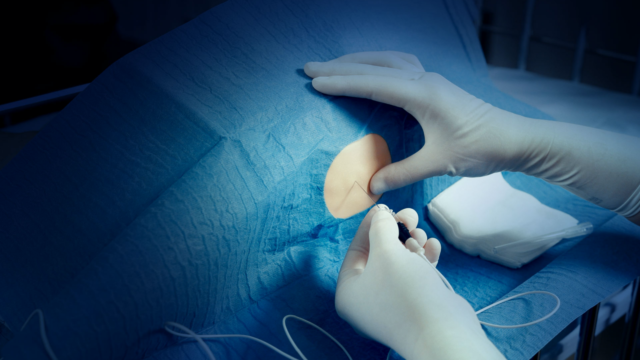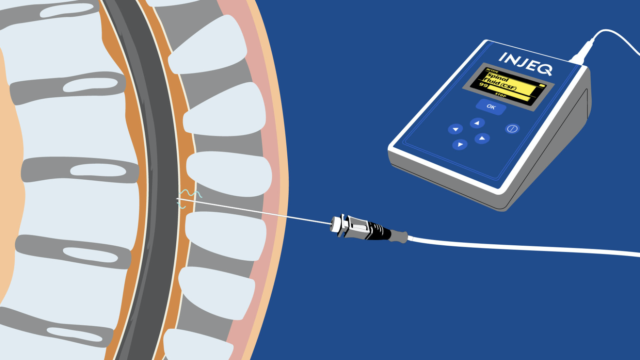Professionals
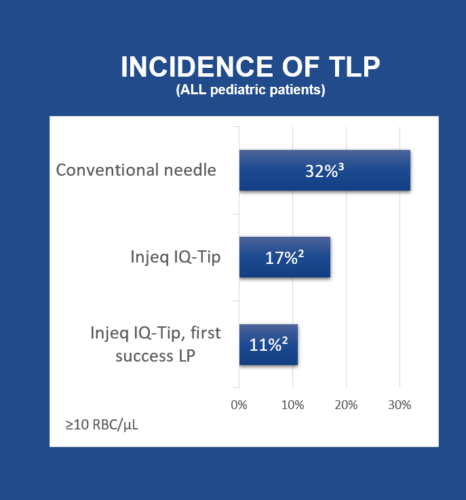
According to clinical investigation of pediatric ALL patients (Långström 2022), the use of Injeq IQ-Tip® system was associated with substantially lower incidence of traumatic lumbar punctures compared to a register-based reference data (Sievänen 2022).
- Blasts in the cerebrospinal fluid (CSF) sample and a TLP increase the risk of malignant events (relapse of the leukemia, other secondary malignancies, or death).
- According to the ALLTogether protocol – a European treatment protocol for children and young adults with acute lymphoblastic leukaemia (ALL) – a CSF sample with blasts leads to additional intrathecal chemotherapy. Bearing in mind that half of the children who die of ALL die from the disease itself, but the other half from the toxic treatment, it is essential to invest on optimal performance in lumbar punctures.
- By calculations with the Injeq IQ-Tip® system one additional child out of 100 children with ALL may survive because of the low incidence of TLP
The use of IQ-Tip system may reduce the incidence of traumatic lumbar punctures in pediatric patients with leukemia
Our recent single-arm clinical study of 150 lumbar puncture (LP) procedures of 50 pediatric patients with acute lymphoblastic leukemia (ALL) showed that the use of the IQ-Tip system is associated with a 17% incidence of traumatic lumbar punctures (TLP) (Långström et al. 2022). Moreover, if the procedure was successful at the first attempt, which was the case in 80% of procedures, the incidence of TLP was 11%.
In our reference data comprising 2507 LP procedures of 250 pediatric hemato-oncology patients, the incidence of TLP was 32% (Sievänen et al. 2022).
Traumatic lumbar punctures are common in clinical practice
According to the scientific literature, the mean incidence of TLP compiled from the pooled data of almost 22400 pediatric hemato-oncology patients is 20% (Gajjar et al. 2000, Howard et al. 2002, Burger et al. 2003, Rech et al. 2005, Te Loo et al. 2006, Marwaha et al. 2010, Cancela et al. 2012, Totadri et al. 2015, Shaikh et al. 2014, Pieters et al. 2016, Sievanen et al. 2022). In individual studies, the reported incidences of TLP vary a lot, ranging from 1% (Marwaha et al. 2010) to 37% (Cancela et al. 2012). The criterion of TLP is 10 or more erythrocytes/μL in the cerebrospinal fluid (CSF) sample, which conforms to the standard definition in pediatric hemato-oncology.
Traumatic lumbar punctures increase the patient’s risk of malignant events
On average, blast cells are present in 59% of CSF samples obtained from traumatic LP procedures of pediatric patients with ALL at the beginning of their intrathecal chemotherapy (Gajjar et al. 2000, Burger et al. 2003, Te Loo et al 2006, Shaikh et al. 2014, Pieters et al. 2016). In individual studies, the reported incidences of TLPs with blasts range from 39% (Te Loo 2006) to 80% (Pieters et al. 2016).
Blasts in the CSF sample and a traumatic LP are known to increase the risk of malignant events (relapse of the disease, other secondary malignancies, or death) (Gajjar et al. 2000, Burger et al. 2003, Te Loo et al 2006, Shaikh et al. 2014, Pieters et al. 2016) compared with patients whose LP procedure was not traumatic and there were no blasts in the CSF sample.
Since the therapeutic practices of pediatric ALL patients have changed during the last few decades, the following speculation on potentially preventable malignancies with the use of the IQ-Tip system relies on the two most recent studies reporting at least five-year follow-up data of event-free survival (Shaikh et al. 2014, Pieters et al. 2016). In these studies, the increased risk of malignancies concerned approximately two out of 10 patients, whose diagnostic LP procedure was traumatic and the CSF sample contained blasts.
Apparent potential for long-term cost-savings with the use of IQ-Tip system?
Assume that we were able to halve the overall incidence of TLPs from 20% to 10% by using the IQ-Tip system in the critical diagnostic LP procedures of pediatric patients with ALL. Then the proportion of blast-contaminated and traumatic LP procedures would reduce to 5% and one additional child out of 100 children with ALL would survive ALL without future malignancies, such as relapse of ALL, brain neoplasms, or even death. Translating these speculative numbers to the European level, where the annual number of new pediatric ALL cases is over 5000 (Namayandeh et al. 2020), more than 50 children would survive ALL every year without future malignancies.
To prevent one TLP-associated malignancy in the long-term, we would need to perform 100 diagnostic LP procedures using the IQ-Tip system and assuming its ability to halve the incidence of TLP. Approximate costs of these malignancies vary from the treatment costs of a neoplasm corresponding to a few 10 k€s to the estimated price of a lost life corresponding to several M€s. For comparison, the average treatment cost of ALL is about 200 k€s. The cost of using 100 IQ-Tip needles to prevent one of these malignancies would be about 10 k€s. This implies actual savings in the treatment costs.
Table 1. shows the estimated annual cost-savings in selected European countries because of prevented malignancies. The incidences of ALL in different countries were obtained from the study by Katz et al (2015). Even tenfold savings may be anticipated. Obviously, the anticipated savings are not immediate but in the long run, they can be substantial to the health care system and society.
Table 1.
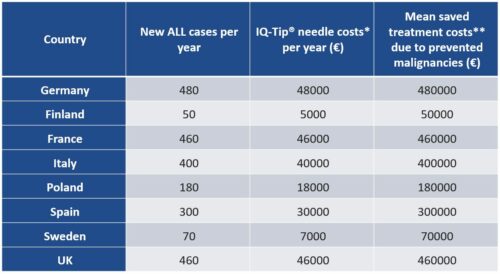
*The unit price of IQ-Tip needle (incl. cable) is assumed 100 €
** The mean treatment cost of a prevented malignancy is assumed 100000 €
Post dural puncture headache (PDPH), a common complication of a lumbar puncture.
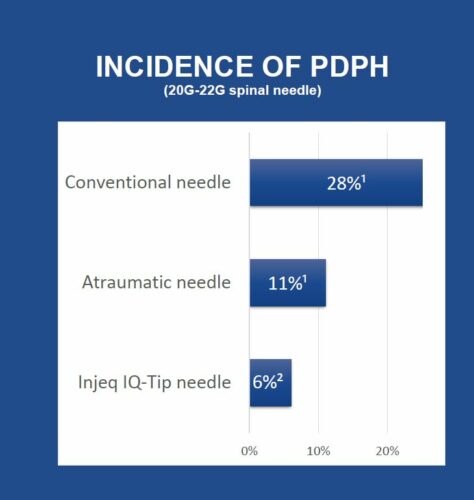
Expenses related to post dural puncture headache (PDPH) in Finland and potential cost savings while using Injeq IQ Tip system
This calculation shows the opportunities to save costs in lumbar punctures in relation to PDPH treatment when the lumbar punctures are performed using the IQ Tip product. The calculation is based on the following research articles: Arevalo‐Rodriguez, I., et al. (2017). Needle gauge and tip designs for preventing post‐dural puncture headache (PDPH). Cochrane Database of Systematic Reviews, (4). This research article shows 24% incidence of PDPH when a lumbar puncture is done using 22G needle. Långström, S., et al. (2022). Bioimpedance spinal needle provides high success and low complication rate in lumbar punctures of pediatric patients with acute lymphoblastic leukemia. Scientific Reports, 12(1), 6799. This research article shows 6% PDPH incidence when lumbar puncture is done using 22G needle IQ-Tip system.
In Finland we did 4927 LPs per year on average between 2010-2020 based on the statistics from THL (Finnish Institute of health and welfare). Based on the incidences presented in the research articles the number of PDPH cases was 1,182 on average. This means that if we can reach the 6% PDPH incidence by using IQ-Tip system we would avoid 886 PDPH cases per year on average.
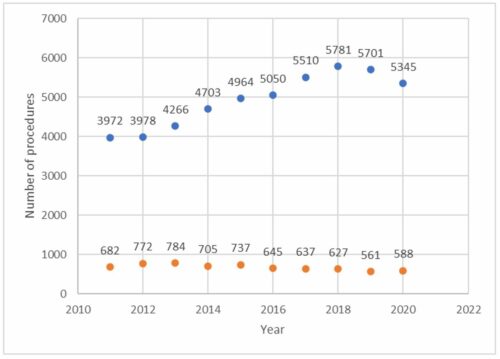
As the treatment of PDPH varies and the relation between LP and PDPH varies, we cannot deduct from the number of LP cases the needed number of Epidural blood patches (EBP) as indicated by the above figure. The
higher number of LPs does not correlate with the number of EBP. What we can say is that in case we can reduce the number of PDPH we can reduce the treatment costs significantly as the treatment day at the hospital
is on the same ballpark with the EBP costs. In some cases, the treatment of PDPH needs both hospitalization and EBP. In addition, some patients may need several days long sick leave because debilitating PDPH that
would lead to substantial societal costs.
The total cost of all LPs per year in Finland is on the level of roughly 2,1M€ (4927 LPs * 435€/LP). If we estimate that the IQ-Tip cost is 70€ higher, the total treatment cost is 2,49M€. This 344,890€ extra cost can be
saved with 648 less EBPs or days in hospital. According to above estimations the IQ-Tip could reduce the PDPH incidence from 1,182 down to 296 cases per annum. Of course, this very rough calculation does not take into account the societal costs nor patient experience and wellbeing, only the associated treatment costs. However, the most important thing is to avoid any extra harm to patients.
"This new needle can be expected to improve the success rate and reduce trauma and bleeding in newborn and in children's lumbar punctures."
– Dr. Hallvard Reigstad (MD), Head of Neonatology Department from Haukeland University Hospital, Bergen, Norway
Video: IQ-Tip® system for Lumbar Punctures
Video demonstrates how real-time spinal fluid identification supports performing safe lumbar punctures using Injeq IQ-Tip® system.
Watch the videoVideo: Injeq IQ-Tip system performance in lumbar puncture
This animation explains Injeq IQ-Tip system performance and cerebrospinal fluid (CSF) detection in lumbar puncture
Watch the video
